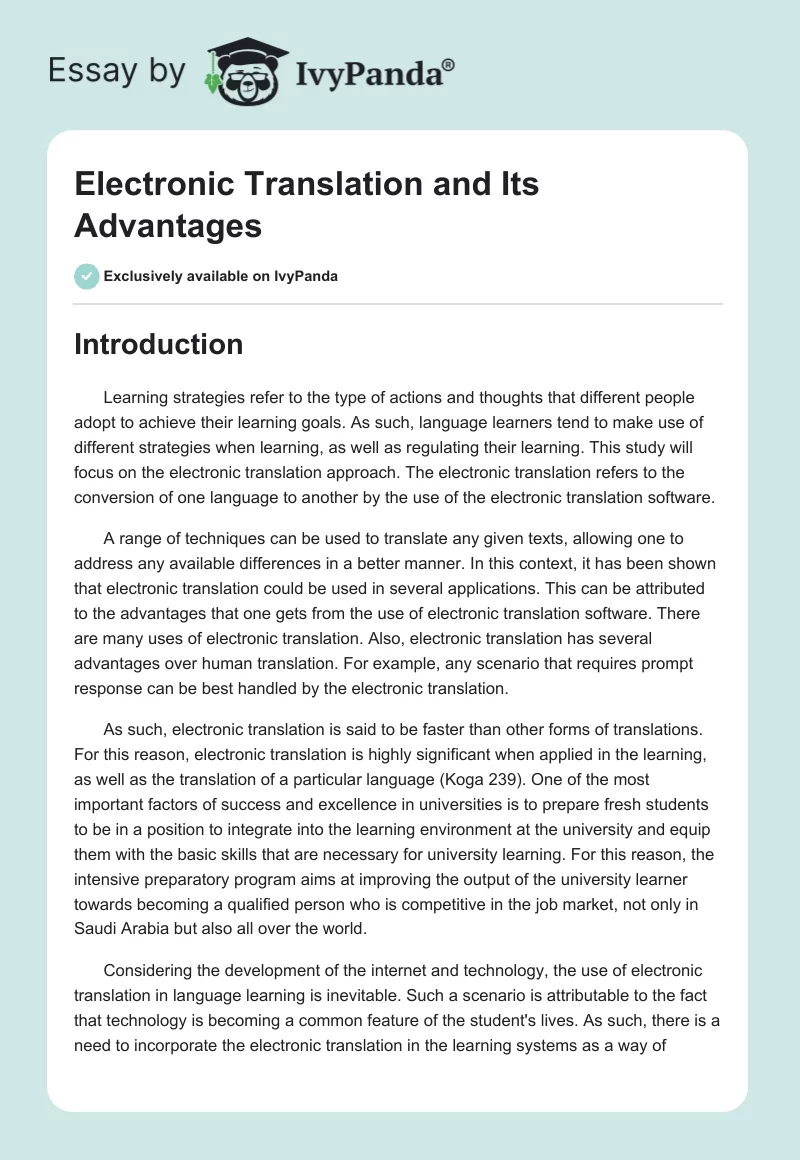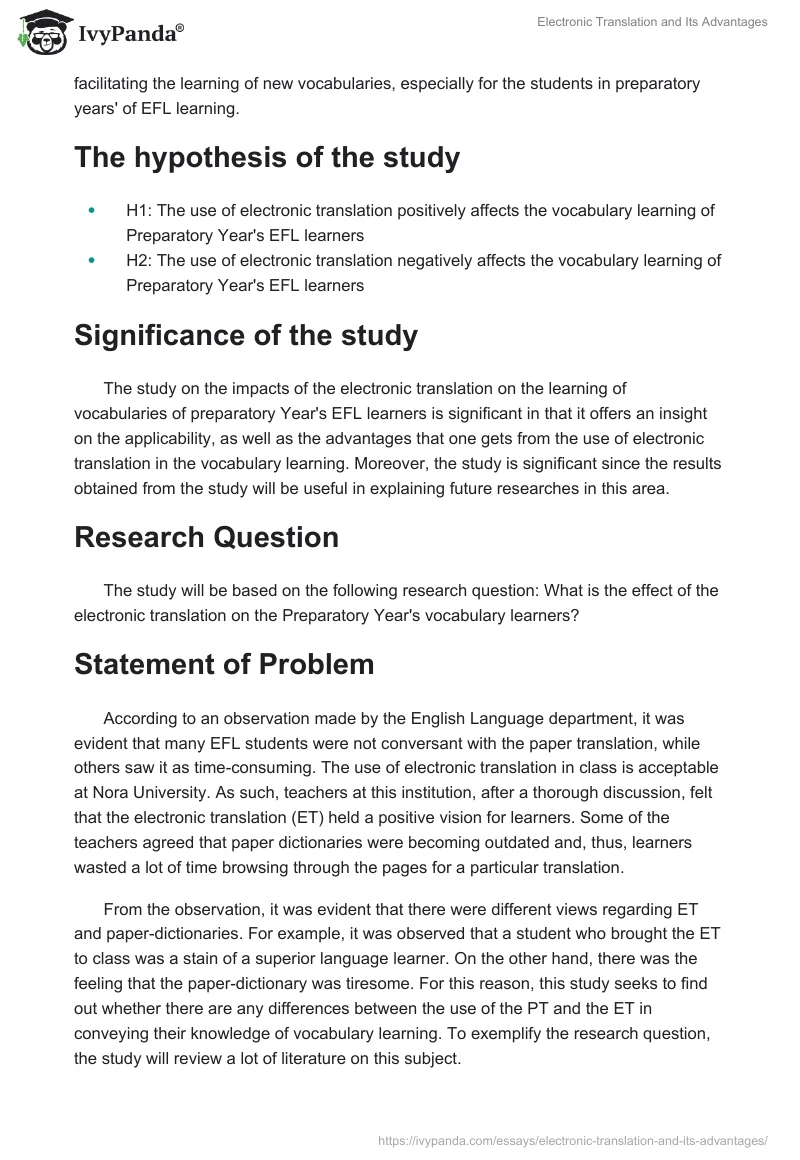Introduction
Learning strategies refer to the type of actions and thoughts that different people adopt to achieve their learning goals. As such, language learners tend to make use of different strategies when learning, as well as regulating their learning. This study will focus on the electronic translation approach. The electronic translation refers to the conversion of one language to another by the use of the electronic translation software.
A range of techniques can be used to translate any given texts, allowing one to address any available differences in a better manner. In this context, it has been shown that electronic translation could be used in several applications. This can be attributed to the advantages that one gets from the use of electronic translation software. There are many uses of electronic translation. Also, electronic translation has several advantages over human translation. For example, any scenario that requires prompt response can be best handled by the electronic translation.
As such, electronic translation is said to be faster than other forms of translations. For this reason, electronic translation is highly significant when applied in the learning, as well as the translation of a particular language (Koga 239). One of the most important factors of success and excellence in universities is to prepare fresh students to be in a position to integrate into the learning environment at the university and equip them with the basic skills that are necessary for university learning. For this reason, the intensive preparatory program aims at improving the output of the university learner towards becoming a qualified person who is competitive in the job market, not only in Saudi Arabia but also all over the world.
Considering the development of the internet and technology, the use of electronic translation in language learning is inevitable. Such a scenario is attributable to the fact that technology is becoming a common feature of the student’s lives. As such, there is a need to incorporate the electronic translation in the learning systems as a way of facilitating the learning of new vocabularies, especially for the students in preparatory years’ of EFL learning.
The hypothesis of the study
- H1: The use of electronic translation positively affects the vocabulary learning of Preparatory Year’s EFL learners
- H2: The use of electronic translation negatively affects the vocabulary learning of Preparatory Year’s EFL learners
Significance of the study
The study on the impacts of the electronic translation on the learning of vocabularies of preparatory Year’s EFL learners is significant in that it offers an insight on the applicability, as well as the advantages that one gets from the use of electronic translation in the vocabulary learning. Moreover, the study is significant since the results obtained from the study will be useful in explaining future researches in this area.
Research Question
The study will be based on the following research question: What is the effect of the electronic translation on the Preparatory Year’s vocabulary learners?
Statement of Problem
According to an observation made by the English Language department, it was evident that many EFL students were not conversant with the paper translation, while others saw it as time-consuming. The use of electronic translation in class is acceptable at Nora University. As such, teachers at this institution, after a thorough discussion, felt that the electronic translation (ET) held a positive vision for learners. Some of the teachers agreed that paper dictionaries were becoming outdated and, thus, learners wasted a lot of time browsing through the pages for a particular translation.
From the observation, it was evident that there were different views regarding ET and paper-dictionaries. For example, it was observed that a student who brought the ET to class was a stain of a superior language learner. On the other hand, there was the feeling that the paper-dictionary was tiresome. For this reason, this study seeks to find out whether there are any differences between the use of the PT and the ET in conveying their knowledge of vocabulary learning. To exemplify the research question, the study will review a lot of literature on this subject.
Review of Related Literature
There has been generated intuitive from previous researches, which emphasized the impact of electronic translation on foreign language learning. Koga (246) differentiated the usefulness of an online Electronic Dictionary and a Paper Dictionary for L2 analysis. Research in this area found out that it was easy for students to read more rapidly in the no-dictionary situation than in the ED situation, and faster in the ED circumstance than in the PD state.
As well, a study by Laufer and Hill (59) pointed out that there is a direct link between look-up and the patterns that result from such projections. Such an association can be seen on a computer screen. The participants were asked to interpret an educational passage on the monitor with admission to dissimilar lexical information of tinted words. The results of this study were stored for future references. Laufer and Hill (57), thus, established that the use of information had a link to improved preservation.
Besides, the major finding of Reza and Zahra (20) in their research about the impact of using the electronic dictionary in the vocabulary learning and retention of Iranian EFL learners study as measured by the instant and belated posttests was that the attainment of the electronic translation collection was enhanced due to instruction contact. As such, the electronic translation proved to be an influential instrument in improving students’ vocabulary learning, as well as their preservation.
In a survey of teacher’s attitudes on the students’ use of portable electronic dictionaries in the EFL/ESL classroom, Midlane (5) claims that the teacher’s approaches may be changing, which distorts the value of portable electronic dictionaries. According to Midlane (5), there are still occurrences in which students’ unnecessarily translation can be seen as counterproductive.
Tang (3) looked at how students used ET in a classroom as compared to PT and found out that eighty-five percent of her sample used their ET to check for word pronunciation and transcriptions. An important result in this study was that the use of the ET involves a linguistic processing mission of the type that can guide one to language acquisition. Also, according to a study conducted by Law (29) on the translation of Chinese words I to English, there was a direct link between the average English language and the successful use of the Chinese-English dictionary. From this study, it was evident that there was a need for the learners to gain knowledge on both the appropriate skills and approach to the use of the dictionary.
Research Methodology
The systematic planning of actions that are applied in the collection of information and subsequent analysis of data in a logical manner that helps in the realization of the purpose of the study is called the study design. It includes descriptive, cross-sectional, experimental, and explorative researches. Research methodology refers to the principles and processes that a researcher applies to collect data that can be utilized in decision making, in business, and/or social setting. This study, as such, will apply the interpretive research philosophy since it focuses on meanings as well as on perceptions.
To achieve the objectives of the research, the study will use a simple random sampling technique to get the sample size. Several types of research have established that simple random sampling is a very effective method, especially in getting a representative sample from a large sample group.
In this case, the sample frame was the female students in the preparatory year at Nora University. The study narrowed down to a sample size of 50 female students. However, the selection criteria necessitated all the students to have studied basic English communication in their first year. The selected students will be given pre-tests and posttests in vocabulary. The electronic translation systems will be applied to translate the vocabularies From English to Arabic. The results of the study will be recorded and analyzed using regression analysis. Such a method of data analysis is preferred since it will effectively outline any significant relationship between the variables under study.
Works Cited
Koga, Yosseh. “The effectiveness of using an electronic dictionary in second language reading.” Bulletin of the Liberal Arts of Hiroshima University, 44.1 (1995): 239- 244. Web.
Laufer, Bernard and Hill Martins. “What lexical information do L2 learners select in a CALL dictionary and how does it affect word retention?” Language Learning & Technology, 3.2 (2000): 58-76. Web.
Law, Wyne. Translation Students’ Use of Dictionaries: A Hong Kong Case Study for Chinese to English Translation. Durham: University of Durham, 2009. Print.
Midlane ,Valeria. Students’ use of Portable Electronic Dictionaries in the EFL/ESL Classroom; A Survey of Teacher Attitudes. Manchester: The University of Manchester, 2005. Print.
Reza , Amos, and Zahra Hassan. The impact of using electronic dictionary on vocabulary learning and retention of Iranian EFL learners. Iran: Hakim Sabzevari University. 2013. Print.
Tang, George. “Pocket Electronic Dictionaries for Second Language Learning: Help or Hindrance?” TESL Canada Journal, 15.1 (1997): 1-3. Web.


